Time:2025-07-17
The Strategic Role of Neon Menu Boards in Fast-Food Dynamics
In the high-speed world of fast-food service, custom neon menu boards have emerged as a transformative tool that merges functionality with brand storytelling. These specialized displays leverage the vibrant allure of neon lighting to highlight menu items, streamline order processing, and reinforce brand identity—critical elements in an industry where customer attention spans are measured in seconds. Unlike static signs, custom neon boards adapt to evolving menus, seasonal promotions, and regional preferences, ensuring fast-food chains maintain consistency across locations while catering to local tastes. This article explores the technical innovations, design strategies, and operational benefits of these dynamic menu solutions, offering a comprehensive guide for franchise owners, brand managers, and restaurant designers.
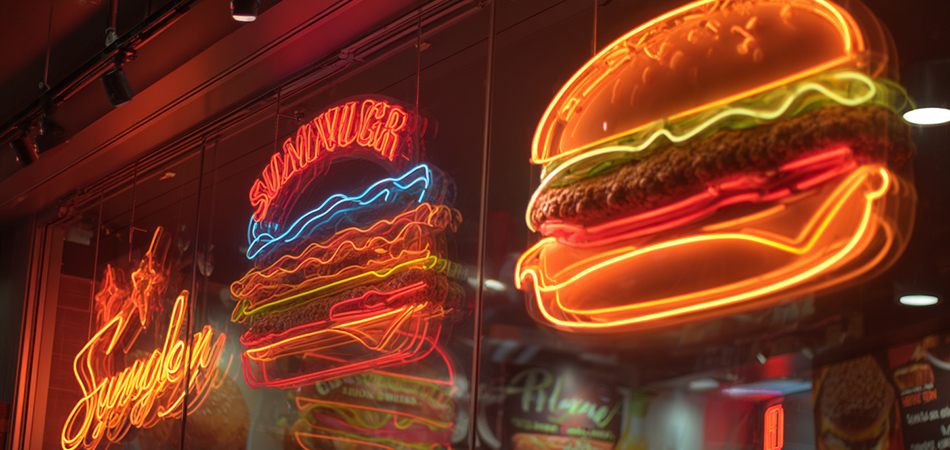
Technical Foundations: Balancing Durability and Flexibility
LED Neon Technology: The Fast-Food Workhorse
Modern Neon Flex Advantages: Custom neon menu boards for fast-food chains rely primarily on LED neon flex—surface-mounted LEDs encased in durable silicone or PVC. This technology offers:
Rapid Customization: Pre-cut segments that can be rearranged to update menu items, prices, or promotions in hours, not days.
Energy Efficiency: Low-voltage operation (12V/24V DC) reduces utility costs, a significant factor for 24/7 or high-traffic locations.
Durability: Resistance to impact, moisture, and temperature fluctuations, ensuring longevity in busy kitchens, drive-thru lanes, and dining areas.
Modular Design for Quick Updates
Segmented Displays: Menu boards divided into interchangeable sections (e.g., “Burgers,” “Fries,” “Drinks”) allow individual components to be swapped out without replacing the entire board. This is ideal for limited-time offers (LTOs) or regional menu variations.
Magnetic Mounting Systems: LED neon segments attach to metal backings via strong magnets, enabling staff to update menus without tools—critical for chains with frequent promotions.
Smart Control Integration: Wi-Fi-enabled controllers sync with POS systems, automatically adjusting neon displays to reflect real-time inventory (e.g., dimming “Out of Stock” items) or time-based promotions (e.g., “Breakfast Until 10:30 AM”).
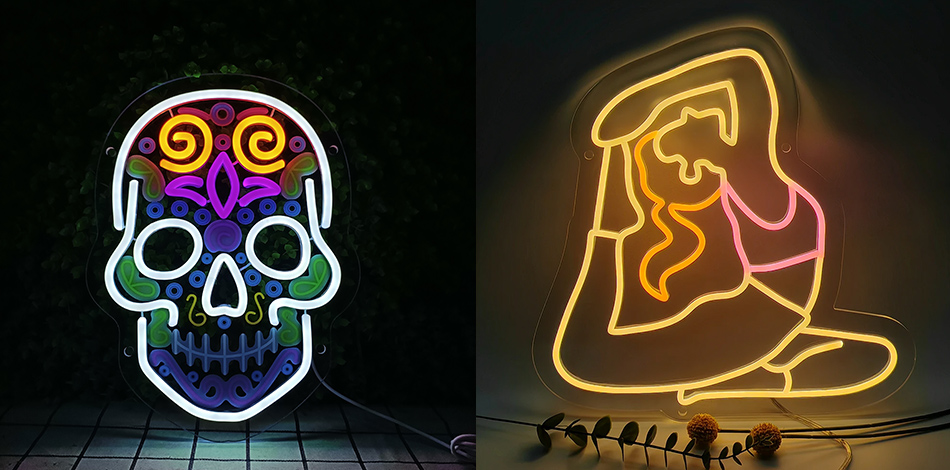
Design Principles for Fast-Food Visibility and Branding
High-Contrast Layouts for Quick Decision-Making
Hierarchical Information Design:
Primary Items: Core menu items (e.g., signature burgers) highlighted with bold, high-brightness neon in brand colors, positioned at eye level (1.5–2 meters from the ground) for easy scanning.
Secondary Details: Prices, add-ons, and nutritional info in smaller, complementary neon hues (e.g., white text on red backgrounds) to avoid visual clutter.
Font and Readability: Sans-serif fonts with thick strokes (e.g., Helvetica Bold) ensure legibility from a distance—vital for drive-thru boards where customers view menus while moving. Avoid decorative scripts that slow down reading.
Brand Consistency Across Locations
Color Psychology and Recognition:
Brand Color Adherence: Neon hues matched to corporate Pantone codes (e.g., red for urgency, yellow for friendliness) reinforce instant brand recognition. A chain known for its blue logo might use blue neon borders around menu sections.
Logo Integration: Subtle neon versions of brand logos embedded in corner spaces or dividers, maintaining identity without overshadowing menu content.
Regional Adaptability: Modular sections allow for localized items (e.g., “Spicy Taco” in Texas vs. “Cheese Curds” in Wisconsin) while keeping core design elements consistent, preserving a unified brand image.
Durability-Focused Materials
Food-Safe Casings: Silicone or PVC neon encasings resistant to grease, cleaning chemicals, and food splatters, ensuring boards remain vibrant in kitchen or countertop environments.
Heat-Resistant Backings: Aluminum or stainless steel backings that dissipate heat from nearby grills or fryers, preventing LED degradation in high-temperature zones.
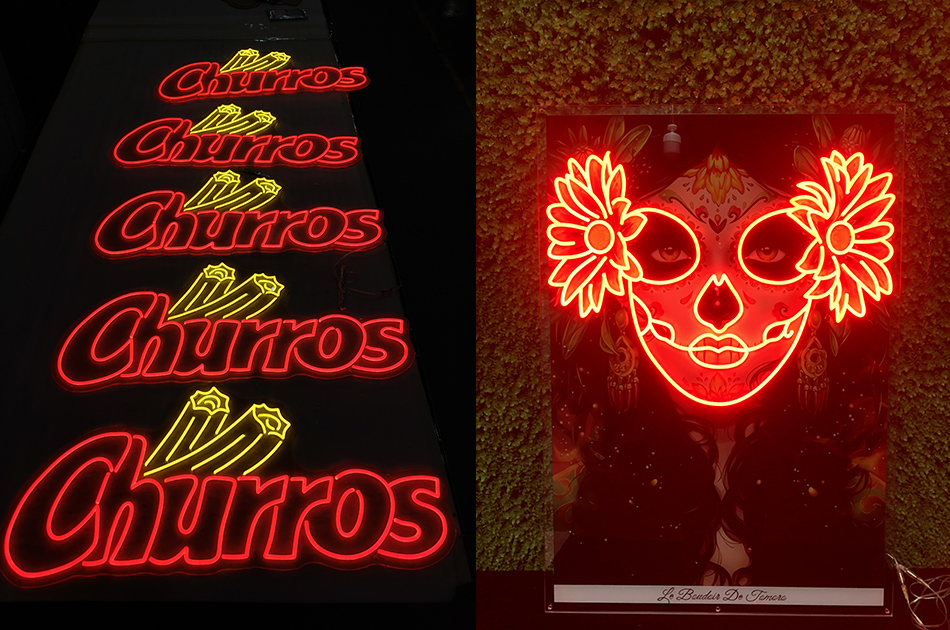
Strategic Applications in Fast-Food Environments
Drive-Thru Optimization
Weatherproof Neon Displays: IP65-rated boards with anti-glare coatings, visible in rain, snow, or direct sunlight. Drive-thru menus use motion sensors to brighten neon when cars approach, conserving energy during lulls.
Sequential Information Flow: Neon boards divided into “Order,” “Pay,” and “Pickup” zones, with synchronized lighting (e.g., green neon highlighting the active step) to guide customers through the process efficiently.
Countertop and Dining Area Menus
Interactive Promotional Boards: Smaller neon displays near registers highlighting LTOs (e.g., “New Chicken Sandwich”) with flashing or pulsing effects to drive impulse purchases. These often pair with QR codes for digital coupons.
Themed Dining Zones: Retro-themed chains use vintage-style neon menu boards (e.g., “Milkshakes” in cursive pink neon) in seating areas, enhancing ambiance while reinforcing brand nostalgia.
Kitchen Communication
Back-of-House Displays: Durable neon boards in prep areas showing order priorities (e.g., “Rush Order” in flashing red neon), improving kitchen workflow and reducing wait times. These are designed to withstand steam, grease, and frequent cleaning.
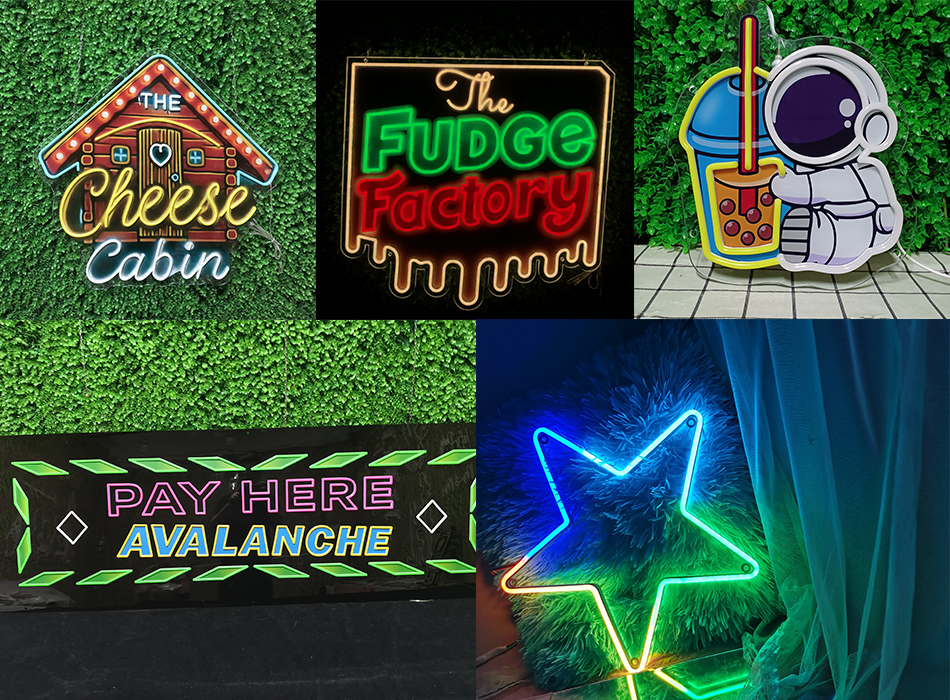
Operational Benefits for Fast-Food Chains
Cost Efficiency and Sustainability
Reduced Printing Costs: Eliminates the need for disposable paper menus or vinyl stickers, saving thousands annually for multi-location chains.
Energy Savings: LED neon uses 70–80% less energy than traditional fluorescent menu boards, with lifespans exceeding 50,000 hours—lowering replacement frequency and maintenance costs.
Brand Consistency and Flexibility
Global-to-Local Adaptation: Centralized design systems ensure core neon elements (colors, fonts) remain consistent across regions, while modular sections allow for local menu items (e.g., regional BBQ sauces) without retooling entire boards.
Rapid Brand Updates: Chains rebranding (e.g., new logos or color schemes) can update neon displays incrementally, avoiding the cost of replacing all signage at once.
Enhanced Customer Experience
Faster Decision-Making: High-contrast neon menus reduce order times by 10–15% in drive-thrus, as customers identify items quickly.
Emotional Connection: The warm glow of neon evokes nostalgia and approachability, strengthening brand loyalty—especially among younger demographics drawn to retro aesthetics.
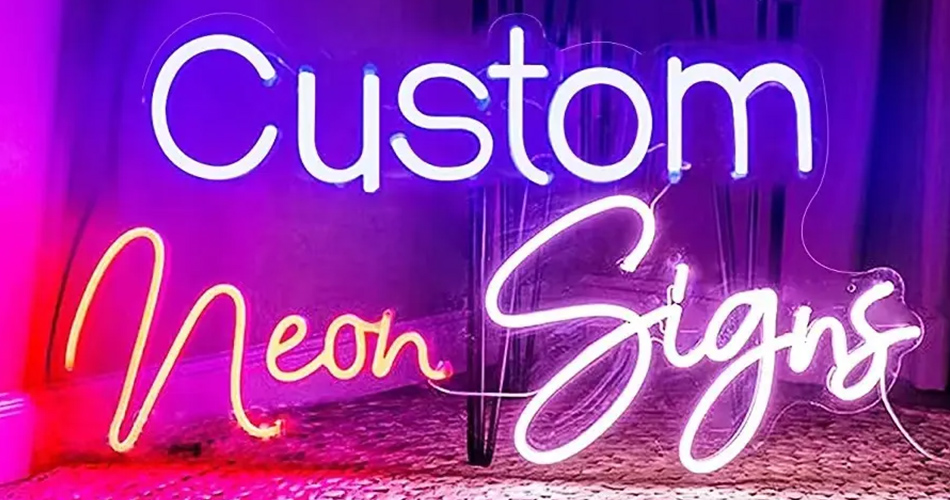
Installation and Maintenance Best Practices
Strategic Placement for Maximum Impact
Drive-Thru Alignment: Boards positioned 3–4 meters from the order speaker, angled 15–20 degrees downward to align with driver line of sight. Anti-glare shields prevent sun glare from washing out neon.
Countertop Positioning: Overhead boards mounted 1.8–2 meters above registers, with lower sections (for kids’ menus) at 1–1.2 meters—ensuring visibility for all customers.
Durability and Hygiene Maintenance
Grease and Moisture Resistance: Regular cleaning with food-safe, non-abrasive cleaners to remove kitchen splatters. Silicone casings wipe clean easily, maintaining light output.
Vibration Resistance: Secure mounting brackets for drive-thru boards to withstand wind, vehicle vibrations, and temperature changes—critical for preventing loose connections.
System Checks: Weekly inspections of LED segments and controllers to ensure all items are illuminated correctly. Backup neon segments stored on-site allow for immediate replacements during peak hours.
Innovations Shaping the Future of Neon Menu Boards
Dynamic Content Integration
AI-Powered Personalization: Cameras and sensors analyze customer demographics (e.g., families vs. solo diners) to adjust neon displays in real time (e.g., highlighting kids’ meals for families).
AR-Enhanced Menus: QR codes on neon boards trigger augmented reality previews (e.g., 3D renderings of burgers) when scanned, bridging physical and digital experiences.
Sustainable Materials
Recycled Components: LED neon flex with casings made from 30–50% recycled silicone, paired with FSC-certified wooden backings for eco-conscious chains.
Solar Auxiliary Power: Drive-thru boards with small solar panels to supplement grid power, reducing carbon footprints in sunny regions.
Durability Enhancements
Self-Healing Coatings: Nanotechnology-infused silicone that repairs minor scratches from cleaning, extending board lifespan in high-traffic kitchens.
Conclusion: Neon as a Catalyst for Fast-Food Success
Custom neon menu boards are more than just displays—they are strategic tools that drive efficiency, reinforce branding, and enhance customer experiences in the fast-paced world of quick-service dining. By combining the nostalgic appeal of neon with modern LED technology and modular design, these boards meet the unique demands of fast-food chains: rapid updates, high visibility, and cost savings.
As consumer expectations for speed and personalization grow, neon menu boards will continue to evolve—integrating smart technology, sustainable materials, and interactive features while retaining their core strength: the ability to make menus pop, even in the busiest environments. For fast-food chains aiming to stand out in a crowded market, custom neon menu boards offer a bright, bold solution that lights up both menus and bottom lines.